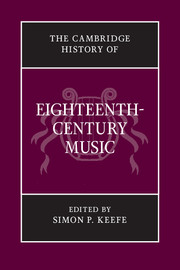Book contents
- Frontmatter
- PRELUDE
- PART I MUSIC FOR THE CHURCH
- 2 Catholic church music in Italy, and the Spanish and Portuguese Empires
- 3 Catholic sacred music in Austria
- 4 Catholic church music in France
- 5 Lutheran church music
- 6 Protestant church music in England and America
- INTERLUDE
- PART II MUSIC FOR THE THEATRE
- INTERLUDE
- PART III MUSIC FOR THE SALON AND CONCERT ROOM
- POSTLUDE
- Appendix I Chronology
- Appendix II Institutions in major European cities
- Appendix III Personalia
- Index
- References
6 - Protestant church music in England and America
from PART I - MUSIC FOR THE CHURCH
Published online by Cambridge University Press: 28 March 2011
- Frontmatter
- PRELUDE
- PART I MUSIC FOR THE CHURCH
- 2 Catholic church music in Italy, and the Spanish and Portuguese Empires
- 3 Catholic sacred music in Austria
- 4 Catholic church music in France
- 5 Lutheran church music
- 6 Protestant church music in England and America
- INTERLUDE
- PART II MUSIC FOR THE THEATRE
- INTERLUDE
- PART III MUSIC FOR THE SALON AND CONCERT ROOM
- POSTLUDE
- Appendix I Chronology
- Appendix II Institutions in major European cities
- Appendix III Personalia
- Index
- References
Summary
Throughout the eighteenth century, the musical traditions of the Protestant churches in the United Kingdom and its New World Colonies were part of an extremely complex and at times fraying fabric. Their diversity was not limited to differing religious traditions but also included varying cultural, social and economic factors within similar traditions that created at times radically dissimilar musical repertories. As the state-sanctioned religion since the Restoration and the Act of Uniformity of 1662, The Church of England (together with the revised Book of Common Prayer) were strong influences on both sides of the Atlantic, and this influence had both positive and negative ramifications. One negative influence was that Catholics, though now tolerated, still had to rely primarily on Latin plainsong disseminated in manuscript copies, many prepared by John Francis Wade (1711/12–86).
Although open to influences from Italian opera, English oratorio and the newer musical styles from Germany and Austria, the dominant musical style of church music during the Georgian era (1714–1830) always maintained a clarity, gravity and restraint partly based on the antiquated language and rhetoric of the authorized Bible, Prayer Book and the newer repertories of English hymns, but also upon the Enlightenment search for order and balance in all things. Given the privileged role of the Church of England in both ecclesiastical and secular society, those institutions most closely associated in London with the royal court and the political life of the nation cultivated the most elaborate and expensive musical styles.
- Type
- Chapter
- Information
- The Cambridge History of Eighteenth-Century Music , pp. 168 - 180Publisher: Cambridge University PressPrint publication year: 2009



